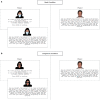Detecting a familiar person behind the surgical mask: recognition without identification among masked versus sunglasses-covered faces
- PMID: 36195737
- PMCID: PMC9531854
- DOI: 10.1186/s41235-022-00440-3
Detecting a familiar person behind the surgical mask: recognition without identification among masked versus sunglasses-covered faces
Abstract
Previous research has shown that even when famous people's identities cannot be discerned from faces that have been filtered with monochromatic noise, these unidentifiable famous faces still tend to receive higher familiarity ratings than similarly filtered non-famous faces. Experiment 1 investigated whether a similar face recognition without identification effect would occur among faces whose identification was hindered through the wearing of a surgical mask. Among a mixture of famous and non-famous faces wearing surgical masks and hoods, participants rated how familiar each person seemed then attempted to identify the person. Though surgical masks significantly impaired identification of the famous faces, unidentified masked famous faces received higher familiarity ratings on average than the non-famous masked faces, suggesting that a sense of familiarity could still occur even when identification was impaired by the mask. Experiment 2 compared faces covered by surgical masks with faces covered by sunglasses. Though sunglasses impaired face identification more than surgical masks, the magnitude of the face recognition without identification effect was the same in both cases. This pattern suggests that holistic face processing is not a requirement for the sense of familiarity with a face, and that different facial feature types can contribute.
Keywords: Butcher-on-the-bus; Face coverings; Face identification; Facial features; Familiarity-detection; Recognition without identification; Sunglasses; Surgical masks.
© 2022. The Author(s).
Conflict of interest statement
The authors declare no competing interests.
Figures



References
-
- Bennetts RJ, Johnson Humphrey P, Zielinska P, Bate S. Face masks versus sunglasses: Limited effects of time and individual differences in the ability to judge facial identity and social traits. Cognitive Research: Principles and Implications. 2022;7(1):18. doi: 10.1186/s41235-022-00371-z. - DOI - PMC - PubMed
-
- Bruce V, Young A. Recognizing faces. In: Bruce V, Young A, editors. Face perception. Psychology Press; 2012. pp. 253–314.
